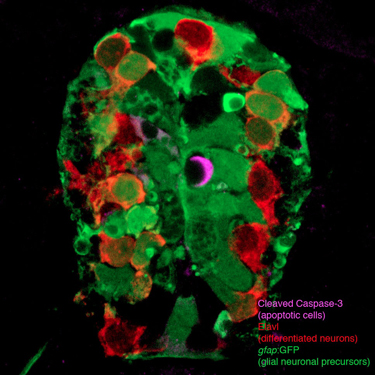A zebrafish model of lethal congenital contracture syndrome
In humans, GLE1 is mutated in lethal congenital contracture syndrome 1 (LCCS1) leading to prenatal death of all affected fetuses. Although the molecular roles of Gle1 in nuclear mRNA export and translation have been documented, no animal models for this disease have been reported. To elucidate the function of Gle1 in vertebrate development, we used the zebrafish (Danio rerio) model system. gle1 mRNA is maternally deposited and widely expressed. Altering Gle1 using an insertional mutant or antisense morpholinos results in multiple defects, including immobility, small eyes, diminished pharyngeal arches, curved body axis, edema, underdeveloped intestine and cell death in the central nervous system. These phenotypes parallel those observed in LCCS1 human fetuses. Gle1 depletion also results in reduction of motoneurons and aberrant arborization of motor axons. Unexpectedly, the motoneuron deficiency results from apoptosis of neural precursors, not of differentiated motoneurons. Mosaic analyses further indicate that Gle1 activity is required extrinsically in the environment for normal motor axon arborization. Importantly, the zebrafish phenotypes caused by Gle1 deficiency are only rescued by expressing wild-type human GLE1 and not by the disease-linked FinMajor mutant form of GLE1. Together, our studies provide the first functional characterization of Gle1 in vertebrate development and reveal its essential role in actively dividing cells. We propose that defective GLE1 function in human LCCS1 results in both neurogenic and non-neurogenic defects linked to the apoptosis of proliferative organ precursors.
